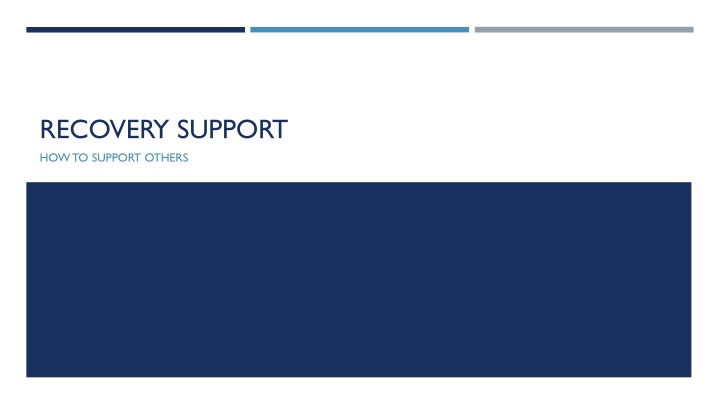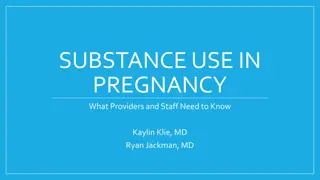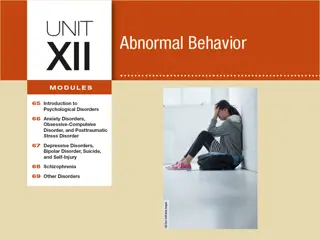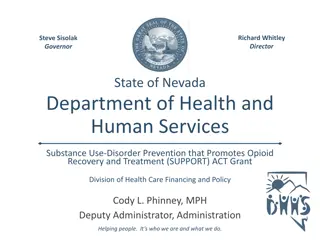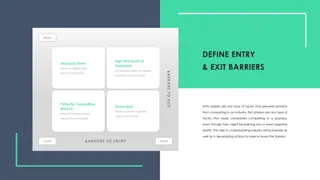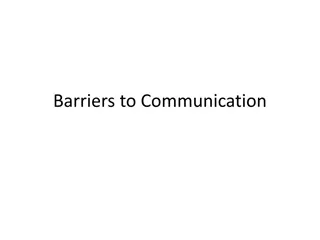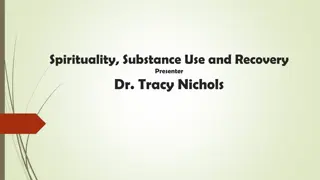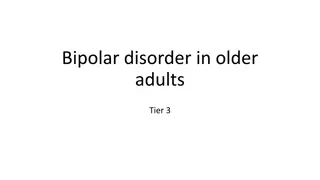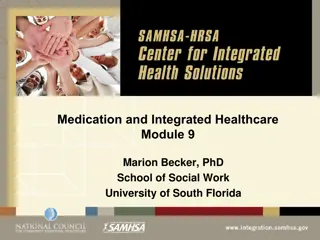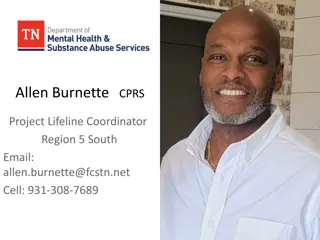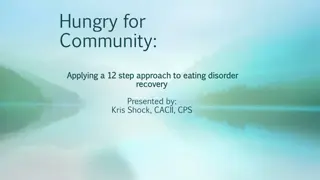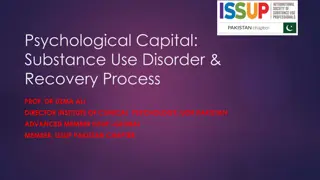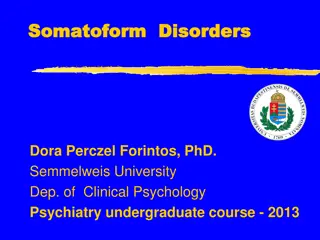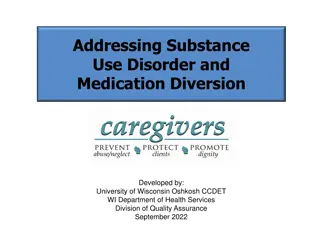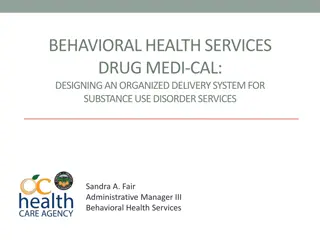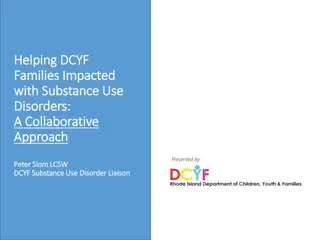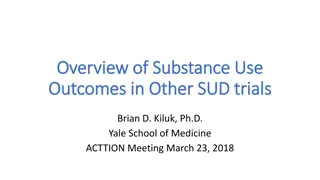Supporting Recovery and Overcoming Barriers in Substance Use Disorder
Explore the challenges and barriers individuals face in seeking treatment and achieving recovery from substance use disorder. Discover the importance of integrating peer support into treatment services to address these obstacles and promote successful recovery across diverse populations.
Download Presentation

Please find below an Image/Link to download the presentation.
The content on the website is provided AS IS for your information and personal use only. It may not be sold, licensed, or shared on other websites without obtaining consent from the author.If you encounter any issues during the download, it is possible that the publisher has removed the file from their server.
You are allowed to download the files provided on this website for personal or commercial use, subject to the condition that they are used lawfully. All files are the property of their respective owners.
The content on the website is provided AS IS for your information and personal use only. It may not be sold, licensed, or shared on other websites without obtaining consent from the author.
E N D
Presentation Transcript
RECOVERY SUPPORT HOW TO SUPPORT OTHERS
SCOPE OF THE PROBLEM 23.5 million (10%) of American adults report being in recovery from a substance use disorder. In light of the current epidemic and the explosion of technology, it would be a missed opportunity not to capitalize on technology to promote treatment and recovery successes.
TREATMENT AND RECOVERY BARRIERS Reasons for not entering treatment: Not ready to stop using 40.3% No health coverage 31.4% Possible negative effect on job 10.7 Concern that getting treatment might cause other to have negative opinions 10.1% Not knowing where to go for treatment 9.2% No program have type of treatment 8.0%
OTHER BARRIERS Lack of awareness of the problem Fear of entering treatment services Time conflicts Admission difficulty waiting list Location of services co-location Co-occurring illness and trauma Stigma
RELAPSE RATES Studies show that more than 85% of patients receiving services relapse and return to substance use within 1 year. Barriers and relapse rates have driven the addiction treatment and recovery support fields to investigate: Expanding peer-based recovery support service and Pioneering new models of post- treatment services.
POLICY CONSIDERATION Peer Support should be fully integrated into all treatment and recovery services and not a self- contained initiative to be abandoned at the moment of discharge. The goal is to transform the entire treatment system to a recovery supporting system. How do we give treatment providers and peer recovery support specialists greater reach and tools to address these barriers
RECOVERY SUPPORT CAN REACH DIVERSE POPULATIONS Sexual orientation Gender identity Race/ethnicity Co-occurring issues Poverty or under-educated Youth Disabilities
RECOVERY SUPPORT ADDRESSES UNMET NEEDS Adolescents Young adults Socioeconomically disadvantaged Frequent movers Latinos and African Americans Those engaging in high-risk behaviors.
MAINTAINING RELATIONSHIP BOUNDARIES Avoid friending clients on personal Facebook pages. Establish protocols for when and how to communicate via technology. Do not monitor clients on social networks, online support groups, or other media. Come to agreement with clients on the boundaries and expectations for online setting.
SAFETY GUIDELINES Have a plan for how to get help during a crisis If someone is harassing or threatening you, remove them from your friends list, block them or report them to the site administrator. Watch out for triggers and think about how to avoid them. Consider unintended consequences, such as increased feelings of isolation.
RESOURCES ON CAMPUSES Counseling Center Student Support Services Veteran Affair Services Student Health & Wellness Center Disability Services Office of Multicultural Affairs Collegiate Recovery Program Public Safety Office Student Health & Medical Center
MUTUAL GROUPS AND RESOURCES Alcoholics Anonymous Narcotics Anonymous Smart Recovery Celebrate Recovery Depression and Bipolar Support Alliance Wellness Recovery Action Planning Active Minds Adult Children of Alcoholics Al-Anon Cocaine Anonymous Dual Recovery Anonymous Gamblers Anonymous National Alliance on Mental Illness (NAMI)
RECOVERY LANGUAGE Words Matter: Language and Stigma Reduction
STIGMA a relationship between an attribute and a stereotype that assigns undesirable labels to a person discredits a person or a group marginalizes affected individuals diminishes achieving full potential
STIGMA IS VISIBLE AND INVISIBLE From within Blame self, feel hopeless Recovery community Medications vs Abstinence Clinicians & medical providers Treatment is ineffective From general public Choice/moral failing vs disease
TYPES OF STIGMA Public Attitudes and feelings towards SUD Institutional Policies, practices, and cultures of orgs, systems Self Internalization
LOOKING AHEAD Be mindful of stigma and discrimination, long before people look for recovery support services Engage with dignified language across the spectrum, including PWUD health, prevention, public health, and harm reduction settings
THE WORDS WE USE ARE CRITICAL Words are important. If you want to care for something, you call it a flower; if you want to kill something, you call it a weed.
SCIENCE OF LANGUAGE In a study, individuals read similar case studies that used different language to make recommendations of care When the subject was described as a substance abuser punitive action was recommended When described as a person having a substance use disorder therapeutic action was recommended This study was replicated with clinicians at two different mental health conferences. Results were the same. (Kelly, J.F., Westerhoff 2010)
SCIENCE OF LANGUAGE General public polled for biases towards PWUD/SUD Bias for people described as Addict Alcoholic Medication-assisted treatment Relapse Positive association toward people described using Long-term recovery Pharmacotherapy Medication-assisted recovery Recurrence of use (Ashford, R.D., et al 2018)
THE POWER OF POSITIVE LANGUAGE Using positive language increases public support for: Effective substance use and mental health disorder policies Additional funding for substance use and mental health disorder services Interactions and engagements with those who are affected by substance use and mental health disorders
EVIDENCE BASED INTERVENTIONS Through Contact Peer storytelling Role modeling Through Education Science of addiction & recovery To peers, families, stakeholders & the community Through Language Use non-stigmatizing & recovery-oriented language Hold each other accountable with teachable moments
WHEN TO USE RECOVERY MESSAGING When speaking to Family Friends Neighbors General public When writing Articles Newsletters Blogging During media interview
HOW TO USE RECOVERY MESSAGING Make it personal Adds credibility Breaks down negative perceptions Speak with one voice Personal stories Consistent messaging Maximum impact Focus on recovery Not the disorder
COMPONENTS OF MESSAGING INTRODUCTIONS Identify yourself Your relationship to recovery Self, family, ally What recovery means to you Why you are sharing your recovery
OPERATIONALIZING RECOVERY Abstinence is not a valid measure Length of time is not an adequate descriptor Recovery is not linear Exclusive affiliation with a type of recovery is not an accurate reflection of the varieties of recovery experience Discerning between remission and recovery
